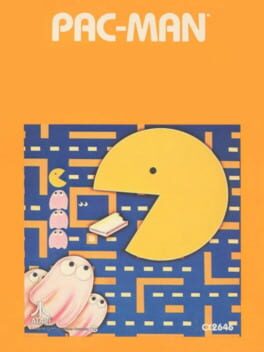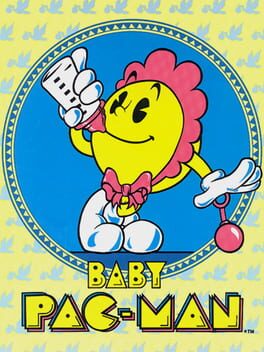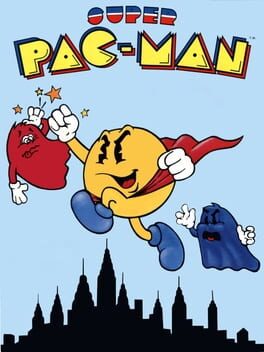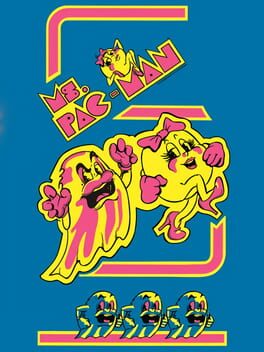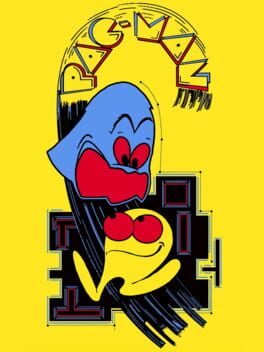

A port of Pac-Man
The player controls Pac-Man through a maze, eating pac-dots (also called pellets). When all pac-dots are eaten, Pac-Man is taken to the next stage. Between some stages one of three intermission animations plays. Four enemies (Blinky, Pinky, Inky and Clyde) roam the maze, trying to catch Pac-Man. If an enemy touches Pac-Man, a life is lost and the Pac-Man itself withers and dies. When all lives have been lost, the game ends. Pac-Man is awarded a single bonus life at 10,000 points by default. Near the corners of the maze are four larger, flashing dots known as power pellets that provide Pac-Man with the temporary ability to eat the enemies. The enemies turn deep blue, reverse direction and usually move more slowly. When an enemy is eaten, its eyes remain and return to the center box where it is regenerated in its normal color. Blue enemies flash white to signal that they are about to become dangerous again and the length of time for which the enemies remain vulnerable varies from one stage to the next, generally becoming shorter as the game progresses. In later stages, the enemies go straight to flashing, bypassing blue, which means that they can only be eaten for a short amount of time, although they still reverse direction when a power pellet is eaten; in even later stages, the ghosts do not become edible (i.e., they do not change color and still make Pacman lose a life on contact), but they still reverse direction.
Also in series
Reviews View More
-Page 1 of the Pac-Man Atari Manual
at that point in 1982, you could probably argue that those words in the manual were the biggest lie ever told in gaming. When it comes to converting arcade games to the ol' 2600, obvious compromises need to be made in order to crunch out that game essence. Some games, like Space Invaders, Asteroids, Defender, Berzerk, etc, make the conversion relatively unscathed. But sometimes you just get some absolute nonsense like Pac-Man. While this game is in literally no means an accurate conversion of the arcade classic, it does show some interesting insight into Atari history both in a cultural and gamedev sense.
So like, the game pretty much shares gameplay similarities with the arcade version and that's kind of it. You eat dots and avoid ghosts that chase you, but compared to the arcade the ghost AI is different, scoring is different, the hitboxes are different, the maze is different, you get the idea. The maze isn't even like a bastardized facsimile of the original, it's just a bunch of circles in a grid. The hitboxes for actually eating the
If you look at this game solely through the lens of how accurate of a conversion this is, it's pretty dire. But ngl this game is pretty cool to look at retrospectively. Atari crunched the fuck out of one guy in 6 months to make something they KNEW would sell millions on brand alone (and sell it did, this is the best-selling game on the system), and so within those constraints the guy likely chose to go for preserving what he believed to be the essence of Pac-Man, rather than trying to make a straight conversion with no proper time or resources. Honestly, the essence still comes through pretty well even in this conversion, and there are probably a solid amount of the 8 million copies sold were probably satisfied casual customers just trying to get their fill of eating dots and chasing ghosts without much care towards the details. It's also just that by 1982 the Atari 2600 was already roughly 5 years old, and Pac-Man was already 2, and many other people had understood standards of what they should be expecting from a first-party conversion of an immensely popular arcade title, and this definitely wasn't up to those expectations. Gaming wasn't a fad anymore, the market of core gamermen had bloomed by this point, and if there's anything we know about those guys it's that they have quite high standards for their gamin. As a result, this game (and it's partner in crime that would release at the end of the year, E.T.) could be described as one of the first games known to the general public as a "bad game", and are frequently cited by historians and fans alike as a major cause of the great American video game crash of '83 as well as being touted as some of the worst games ever made in the later internet sphere of things.
Do I think this game really deserves that kind of reputation though? I mean, kind of? It's not nearly as ambitious as something like E.T. and is a pretty blatant result of Atari cutting corners to get as much easy profit on their grubby hands at the cost of making a quality product for their consumers, so it's not exactly like this game is great or misunderstood or anything imo. The Atari could absolutely have done a more direct conversion of Pac-Man, as both the Ms. Pac man port and plenty of 2600 homebrew can prove, so it's not like it was entirely the hardware at fault either. I just think that the end product is such a fascinating result of so many factors that it's hard not to be curious about it. It will obviously never happen, but I do wish Namco would reference this bizarro version of Pac-Man or include it in compilations as a historical curio or something. If they had a 2600 pac-man skin in a championship edition game or something I would absolutely pop the fuck off ngl. I definitely still wouldn't really recommend it to anyone outside of the curious gaming historians out there in this day and age, but an absolute bottom-of-the-barrel irredeemable worst-game-ever-made this game is certainly not.
2 years late and barely recognizable, Pac-Man hit the Atari 2600, a system which it probably never should've touched. The attempt is admirable, but the VCS was clearly showing its age by 1982, and it was not suited to ports of the games that were popular in arcades. At the time this was pretty much the closest you could get to Pac-Man at home, but just a year later the Intellivision got its own port of the game, which is much more arcade accurate, and even the cancelled Coleco port holds up better.
This game is semi-often cited as one of the causes of the crash of 1983, and while it's far from the worst 2600 game on the market at the time, it's an easy one to pick on. The 2600 simply was not good enough at this point to handle the types of games that it was being tasked with, and if a console that was already 5 years old was propping up the entire North American video game market, it's not hard to see why it would crash.
I've focused a lot on this game's historical context, and not very much on the game itself, and that's because there really isn't much to say. Everything about this game feels like a weird bootleg version of itself both mechanically and visually. The maze is heavily simplified even compared to the original game, the ghost AI is less interesting, and it's just generally much easier.
Unless you have a strong desire to, don't play this version. The arcade version is available on pretty much every system nowadays anyway, while the only way to play this port legally is on the original hardware.
